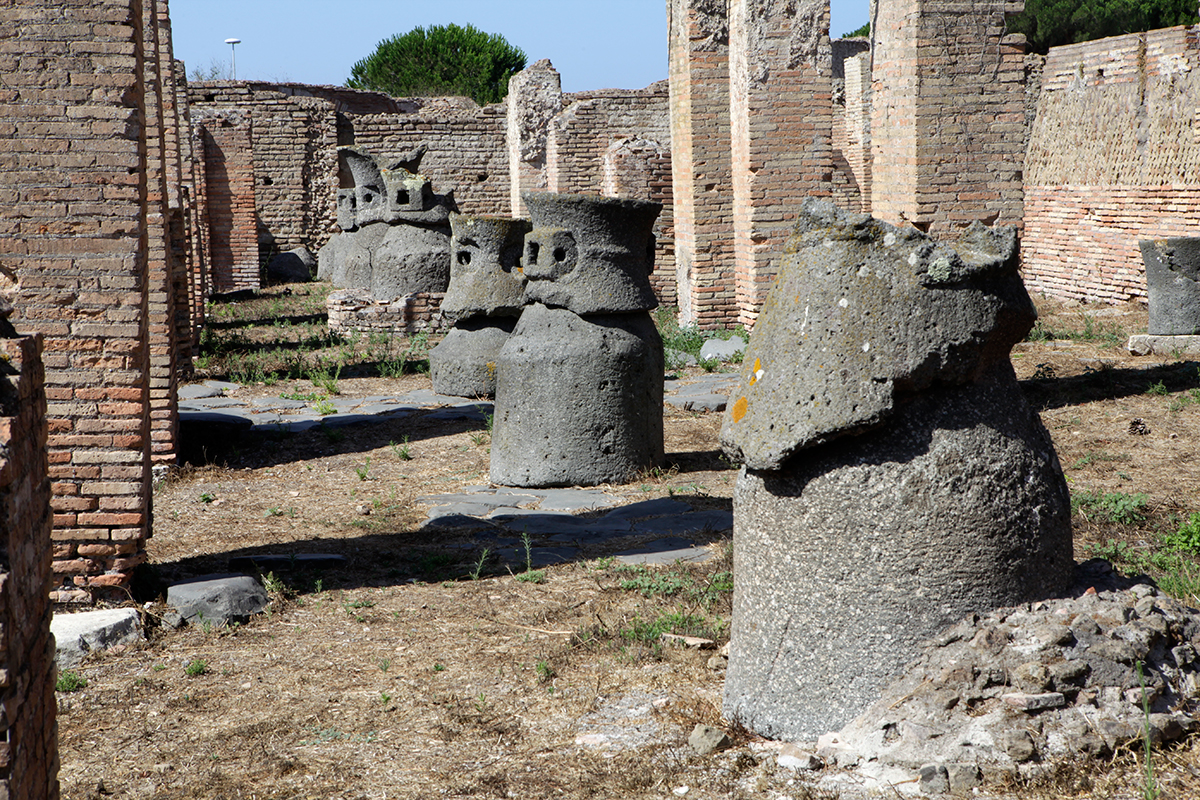
In many articles we showed how important grain was for Rome. The grain supply ensured the control over the population under the slogan ‘Panem et Circenses’ (Bread and circuses), as we saw in our article ‘Eating from the African Bowl’ and in the many ‘stationes’ behind the theatre in Ostia (read the article ‘Overseas trade’ ). Grain was indeed mostly used to make bread and had to be ground first into meal. Before the invention of the watermill the grain was ground by the baker himself. Although, not by himself but by slaves or animals (donkeys or horses).
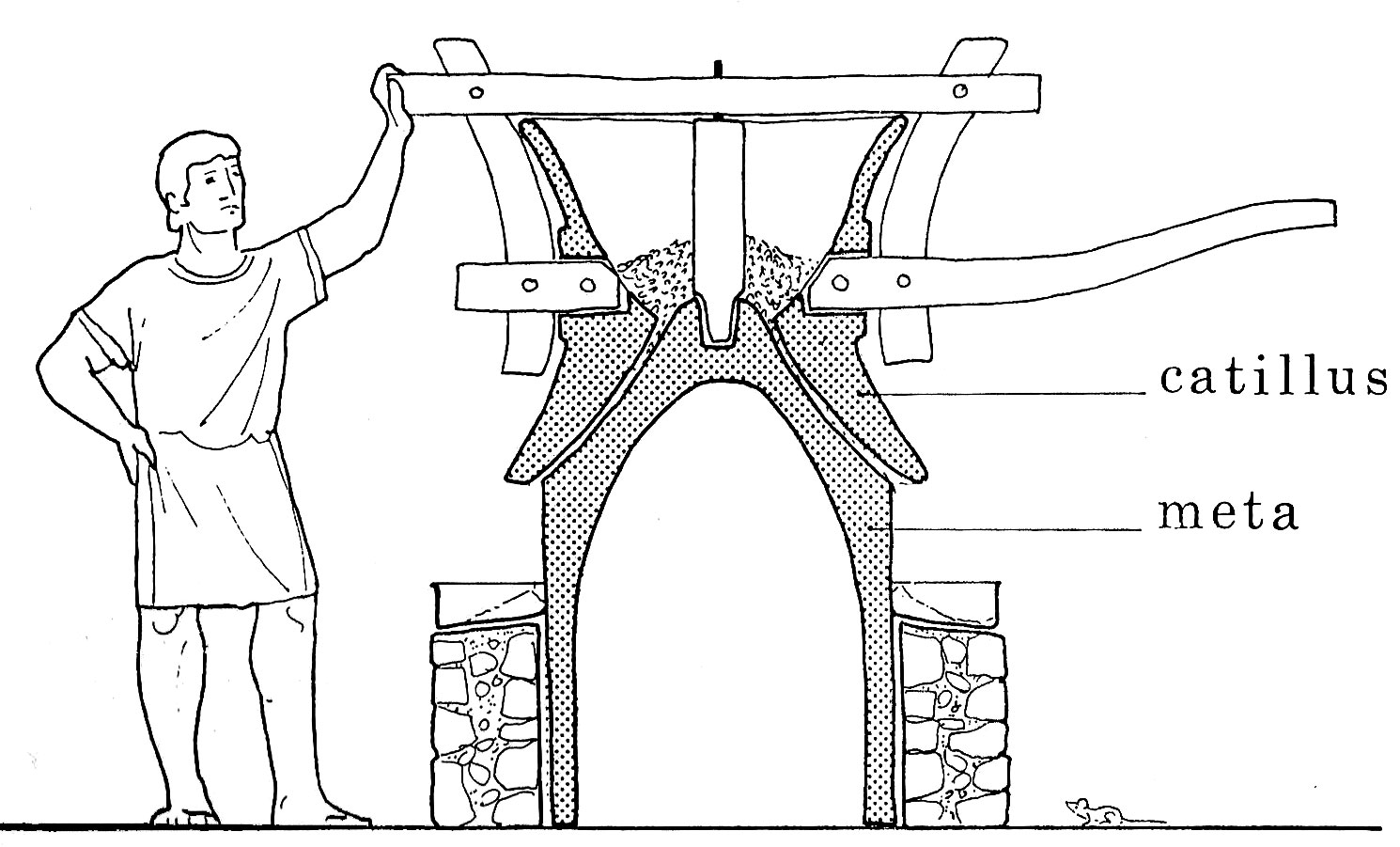
The bakeries were equipped with machines existing of a bell-shaped upper part (catillus) and a cylindrical lower part (meta). The catillus, in which the grain was poured via a hopper, was rotated by the animals. Grain was ground between the two parts and the meal collected at the bottom of the lower part. Slaves urged the animals on with a whip, filled the hopper and collected the meal. After the grinding and sieving the dough was made. Also machines for the kneading were operated by people or animals. The bread was than moulded and baked. The whole process is described in the video ‘Casa dei Molini’. Although some bakeries were equipped with several millstones the capacity of grinding the grain was very low, costed a lot of labour from man and animal and the work was very unattractive.
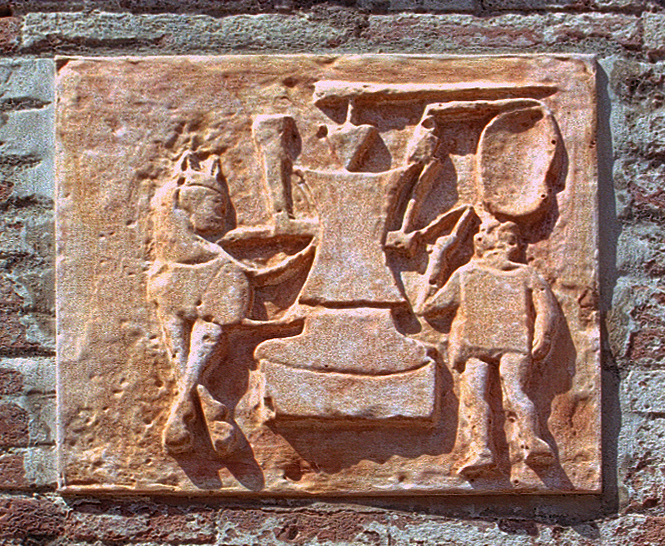
Apuleius desribes it as follows: My gods, what a set of men I saw! Their skins were seamed all over with marks of the lash, their scarred backs were shaded rather than covered with tattered frocks. Some wore only aprons, all were so poorly clothed that their skin was visible through the rents in their rags! Their foreheads were branded with letters, their heads were half-shaved. They had irons on their legs. They were hideously sallow. Their eyes were bleared, sore, and raw, from the smoke of the ovens. They were covered with flour as athletes with dust!" 2
With the increasing of the population another technic for grinding the grain came into view; the vertical watermill. These mills had a much higher gear ratio than the “hourglass” mills operated by animals. The water was obtained from rivers, wells, aqueducts and baths4.
Although the vertical watermill was already known in the first century, its widespread commercial use began at the end of the second and in the third century AD. Watermills for grinding grain have been found in several places in the Roman Empire, but the most famous mill is the Barbegal, discovered in 1937, near the Roman city of Arelate (modern Arles). Because the watermills needed a large supply of water the grinding machinery was separated from the bakeries.
According to Forbes5 watermills were six times as efficient, ground 150 kilograms per hour and could deliver meal (or flour) to several bakeries in the city.
THE BARBEGAL MILL
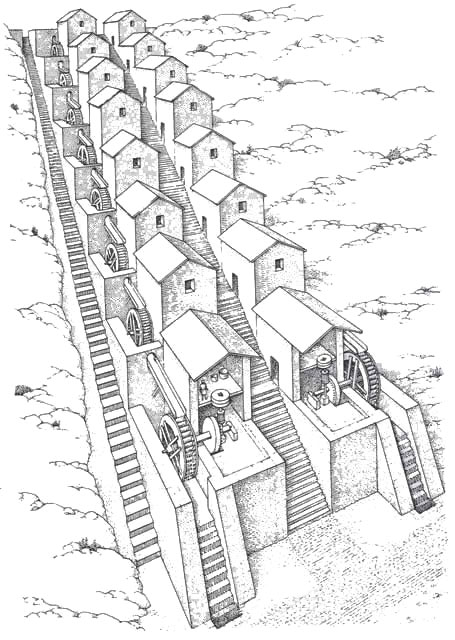
in the open)6
The Barbegal, was an enormous watermill featuring a large complex of 16 wooden wheels fed at the top wtare coming from 38 miles (60km) of aqueducts. As water cascaded down the wheels, it turned a gear system that crushed grains into flour, which was then transported to the city.
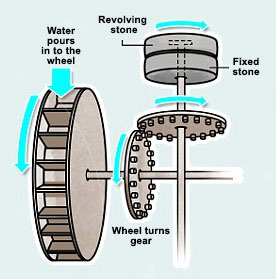
The Barbegal could have processed 24.000 kilograms in 10 hours, enough for approximately 21.400 people. The seize of the population in third-century Arles may have been 10.000 and Forbes suggested already that the Barbegal also served the army. New research have shown now that he was probably not far away from the truth with his suggestion.
NOT FOR BREAD ONLY
Until now, researchers had thought the site was only used to supply flour to the nearby Roman city of Arelate. However, scientists at the Johannes Gutenberg University in Mainz, Germany, analysed limestone found at the site shortly after its discovery in 1937. The deposits had built up on the water-wheels as they churned through the water coming from the aquaducts. These deposits are all what is left of the ancient wooden mechanism, which had already disappeared centuries ago.
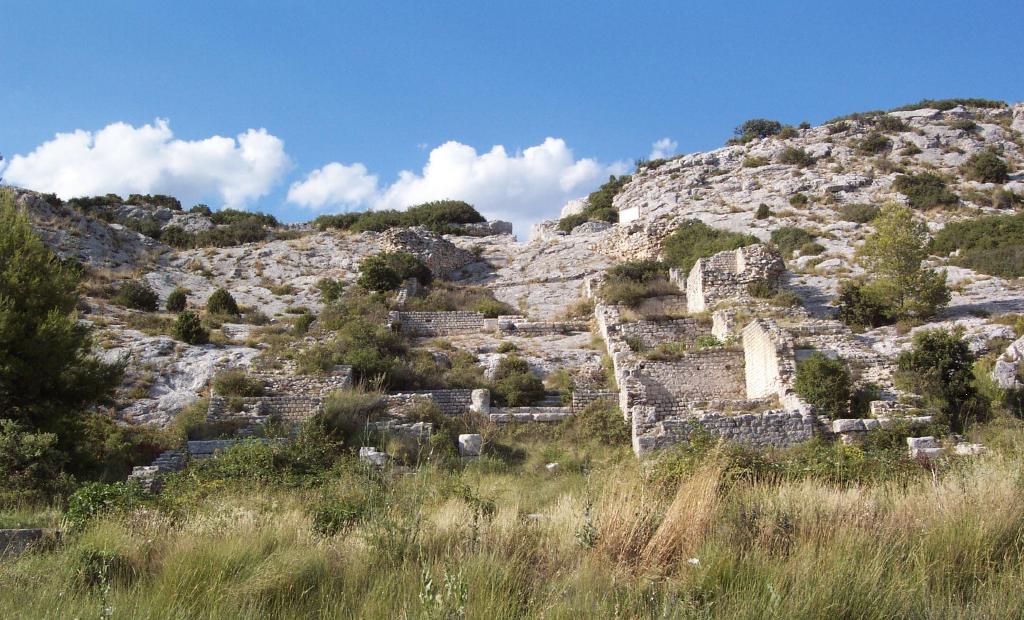
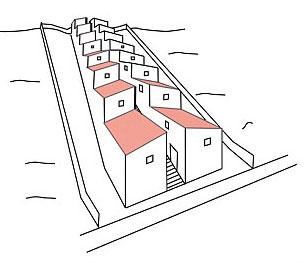
with photo 4
Researchers said the crystalline structure of the limestone deposits reveals they were formed in the dark by fast-flowing water. This suggests the waterwheels were actually kept inside small huts that lined the hill, rather than outside, as previous research has suggested (see photo 4). The new chemical analyses of the ancient limestones deposits showed also that the installation stopped turning in late summer and autumn.
If the meal was used for bread for the population of Arelate, as has been suggested, the mill should have functioned throughout the whole year. So there must be a reason why the production stopped a couple of months every year. Could it be that the outlet for this meal was not available during the winter months? Meal doesn't store as well as grain. We know also that the Romans hardly sailed during autumn and winter (see the article ‘Wintershipping’). Could this be a connection? This brings us back by mr. Forbes. Probably the meal was partly shipped to Rome or other parts of the Roman Empire and partly used for making a ship biscuit for sailors called ‘bucellatum’, an equivalent of hardtack. After all, Arelate was a Roman Naval Port (the Roman legion Legio VI Ferrata had its base there) as well as a commercial Port (see 'Arelate')
The snacks formed a staple part of a sailor's diet during long voyages at sea. And again, if you didn’t sail during the winter months, you didn’t need meal for the export or bucellatum for the sailors during those months. These simple snacks were incredibly popular among sailors before the invention of canned goods. The biscuits lasted weeks without rotting or going stale. The late-Roman Codex Theodosianus, a compilation of Roman laws, states that during expeditions a Roman soldier should be supplied with "buccellatum ac panem, vinum quoque atque acetum, sed et laridum, carnem verbecinam." or "hardtack and bread, wine too and vinegar, but also bacon and mutton." 8. So it could be that world's oldest biscuit factory has been discovered in southern France.
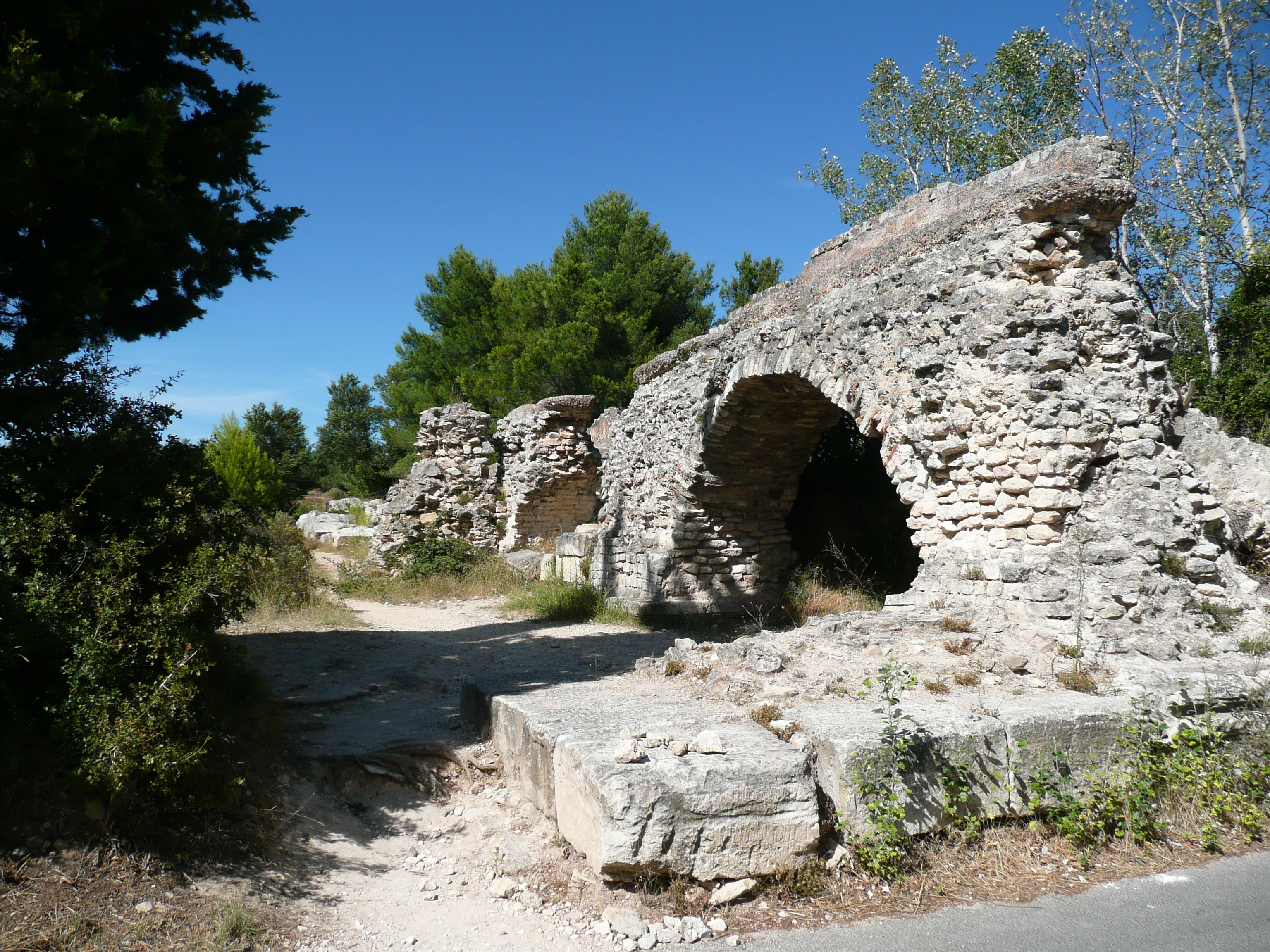
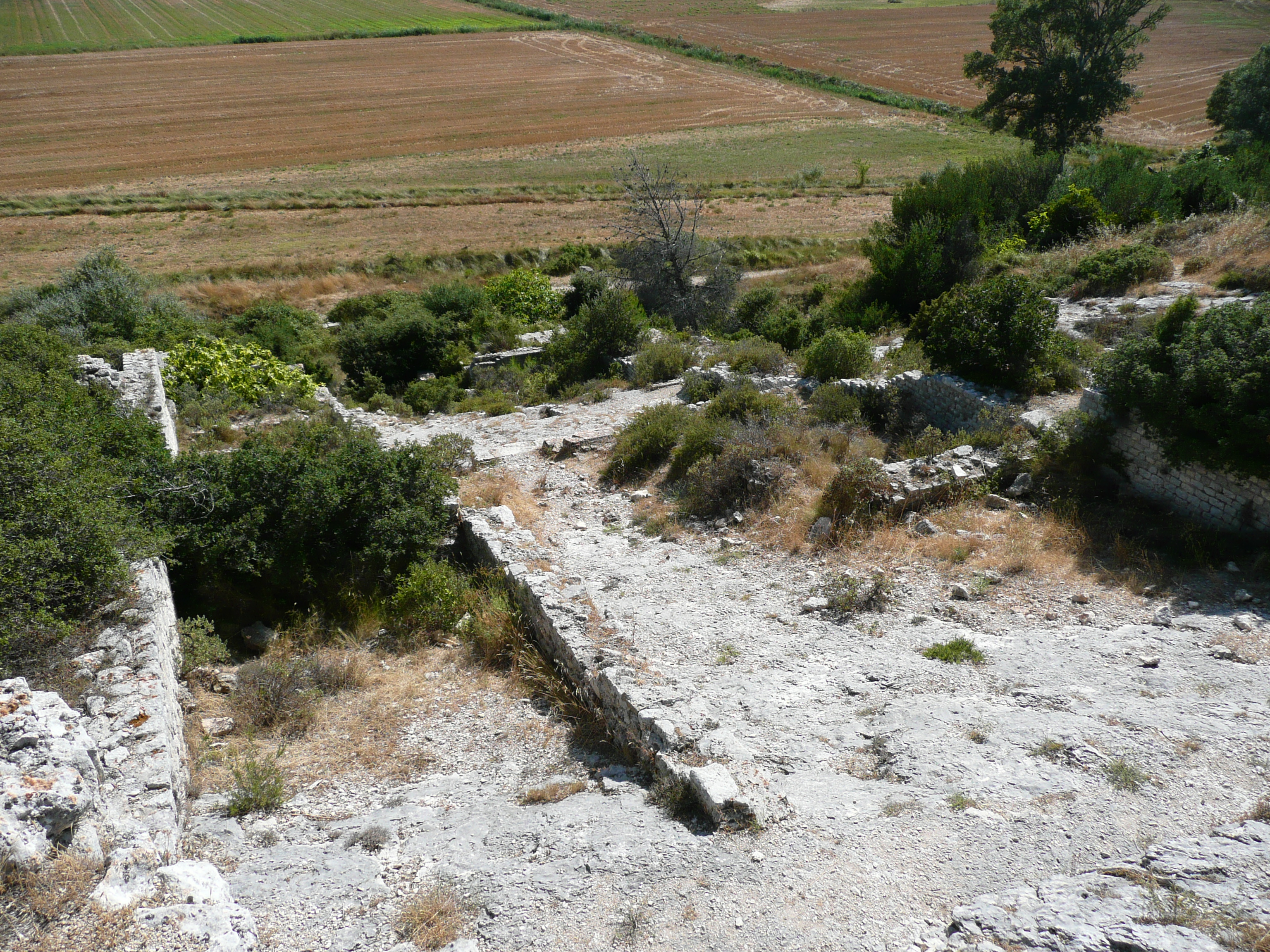

Sources:
How Romans made their BISCUITS, Harry Pettit for Mailonline
The mills-bakeries of Ostia, Jan Theo Bakker, J.C., Gieben, Publisher, Amsterdam 1999
Pass the garum, Neill George 2012
- notes:
- 1:Illustration: Adam 1984, fig. 735
- 2: Lucius Apuleius Madaurensis, a Numidian writer in 123-125 in his ‘Metamorphoses’ 9, 12, 3,4: Dii boni, quales illic homunculi vibicibus lividis totam cutem depicti dorsumque plagosum seissili centumculo magis inumbrati quam obtecti, nonnulli exiguo regili tantum modo pubem iniecti, cincti tamen sic tunicate, ut essent per pannulos manifesti, fronts liiterati et capillum semirasi et pedes anulati. Tum lurore deformes et fumosis tenebris vaporosae caliginis palpebras adesi atque adeo male luminati et in modum pugilum, qui pulviculo perspersi dimicant, farinulenta cinere sordide candidate
- 3: Relief on the wall of tomb 78 on the necropolis of Isola Sacra. A horse rotates the upper part of the mill and a slave handels a whip.
- 4:Rutilius Taurus Aemilianus Palladius, a Latin writer probably from the 4th century AD wrote in his Opus Agriculturae (also called De Re Rustica)I 41 (42): "Si aquae copia est, fusuras balnearum debent pistrina suscipere, ut ibi formatis aquariis modis sine animalium vel hominum labore frumenta frangantur". Translation: "If there is an abundant supply of water, the bakeries should receive the waste water from the baths, so that the grain can be crushed in watermills constructed here without the toil of animals or men". A small watermill has been found in underground rooms in the Baths of Caracalla in Rome.
- 5: R.J.Forbes, Studies in Ancient Technology II, Leiden1965, 93-95
- 6: Trevor Hodge 1990, figure on page 61
- 7: Leo Delauncey/Mailonline/Scientific Advances 93-95
- 8: Codex Theodosianus VII.4.6
- -: Photo 9 and 10 : Wikipedia, Maarjaara






 We are committed to providing versions of our articles and interviews in several languages, but our first language is English.
We are committed to providing versions of our articles and interviews in several languages, but our first language is English.